Welcome to the
(Video) Library
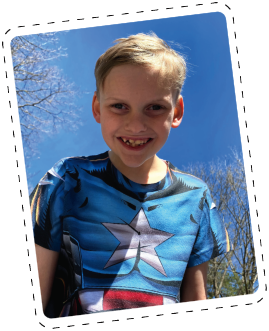
REAL PEOPLE TAKING LIVMARLI
Hear from real patients and their families as they share their unique experiences—life before diagnosis, challenges before starting LIVMARLI, and the difference LIVMARLI is making in their lives.*
*Not all patients taking LIVMARLI will have the same experiences.


Meet Emma and Abby
Emma and Abby share their young-adult perspectives on growing up with cholestatic pruritus and how LIVMARLI helped relieve their symptoms.
Chapters


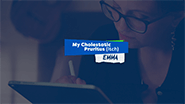
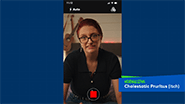


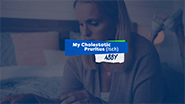








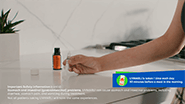

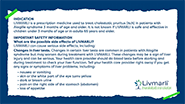
[00:00:00]
[music]
Emma: I’m Emma. I’m 19, and I’m from Washington State. I was diagnosed with Alagille syndrome very soon after birth. [00:00:30] I had the symptoms of jaundice, prominent facial features, and low bile duct count. When I was about 4 or 5 years old, I realized I had Alagille syndrome. That meant for me that I had a lifelong illness that I had to manage.
One of the main symptoms for Alagille syndrome is cholestatic pruritus. My itch was pretty severe. It’s [00:01:00] like bugs under your skin almost. It’s just something you constantly have to soothe and you just can never soothe it. Daily life for me would be very disrupted. I would have to itch before I even went into public. I managed the itch by scratching, or if it was a lot, I would take ice baths and lotion stuff, but they’re temporary relief. It was hard to maintain friendships, relationships with people along with schooling. It was very [00:01:30] hard to focus because my main focus was just the itching. It’s very sensory, overwhelming.
The itching just became my everyday life. No matter how severe it was or how bad it was that was just my life. I just lived with it. Looking back, I’m like, that was not normal. I got on the clinical trial for LIVMARLI when I was 12. I’m 19 now, so [00:02:00] that was 7 years. I’ve been taking it every day since then.
[music]
Abby: I’m Abby. I’m 26 years old and I’m from Huntsville, Alabama. I was 11 months old when I was diagnosed with Alagille syndrome. The symptoms that led me to being diagnosed was I was itching from the time that I was able to start to itch. I was not growing, and I was jaundiced. [00:02:30] I believe at the age of 10 and 11, I started to understand what Alagille was and what it meant for the rest of my life. I knew that I was always going to have something wrong with my liver, and I knew that I was always going to have to go to doctor’s appointments and take medication, and those are just some of the symptoms that stood out to me.
[music]
My itching would start bright and early in the morning and progressively get worse throughout the day. Some of the medications, physicians [00:03:00] were offering me were cholestyramine and hydroxyzine. They had me on rifampin at one point, and none of those helped. Then at around almost 2 years old, I had a biliary diversion and I lived with that for my entire life, until I was 19. Even with the diversion, the itching was still there. I still scratched my feet on the [00:03:30] carpet.
The palms of my hands would itch. My legs would itch, so I would still have to try to use other methods to help my itching. It was very difficult to go to school and have social interactions and do things. As a kid with the pruritus, you feel very alone a lot of the time. Looking back, the pruritus has always been normalized for me. It was just something I had to live with.
I have a really good support system, always have, but [00:04:00] I wish I had physicians advocating a little bit more for me because the pruritus is a real thing and it is very debilitating. It is awful. I encourage anyone that your pruritus affects your day-to-day life, and that you have normalized to talk to your physician and let them know how it affects you and see where you can go from there. [00:04:30]
Emma: Hello.
Abby: Hi.
Emma: At what point did you realize how bad the itching was? Did you find that out or someone else had to point that out?
Abby: I mean, I always knew it was bad. I always knew it was bad. It was no secret. I feel like when [00:05:00] my husband and I went to a doctor’s appointment maybe 2 years back, and he asked the doctor if there was anything that would help with the itching, I think that’s really when it was like, “Oh, okay. It really is like that noticeable and that bad.”
Emma: Yeah. I feel the same way. I knew it was bad, but I think it was me seeing the reactions of other people. We’d go in public, my mom would get so strict. She’s like, “Stop itching. Stop itching.” She’d whisper it to me. I’m like, “I didn’t even know [00:05:30] I was doing it.” Or, at school, I remember I liked this one boy, and I’d be talking to him. He’s like, “What are you doing?” I find out I’m doing this the whole time, while I’m talking to him. At what point did the itching get so bad that you’re like, “I need to get something like treatment?”
Abby: Well, my parents made that decision for me early in life, and I had the diversion done, but then when I was 19, I got it reversed. After the reversal, [00:06:00] I knew that it was going to be tough because even going from one thing to another, your body has to have time to adjust. I tried several different things, like the allergy medications you can take. Nothing helped me sleep all the way through the night if I was having a bad day. I think I remember we used an anti-itch lotion, and I don’t remember it helping at all.
[music]
Abby: [00:06:30] How did you hear about LIVMARLI? How old were you? How did that all come about?
Emma: I was about like fifth grade. My mom’s always been a big advocate, so she’s always on the hunt for something. She found about LIVMARLI. I got in the clinical trial. I was in that for about a month before I got on the medicine. Then we took like a week or 2, and I [00:07:00] started seeing results. What about you? How did you hear about LIVMARLI?
Abby: A physician reached out to me to educate me about LIVMARLI, and then the physician got in contact with my doctor after I said I was willing to do it and then I was able to start on it. I’m very glad he reached out to me. If he didn’t, I don’t think I would be in the place I am today. I would still be itching all the time.
Emma: I don’t [00:07:30] know what my life would be like. I don’t really want to go back to the itching.
Abby: That’s how I feel too. I feel like I lived my whole life with it, so I don’t want to go back.
Emma: When I started taking LIVMARLI, for the first couple weeks, I noticed myself I didn’t need as much time itching, or I could focus in class. That was a big one, where I wasn’t constantly fidgeting.
Abby: I started noticing being able to sleep better and [00:08:00] stay asleep all night long. Before, sometimes I would wake up in the middle of the night and have to scratch or itch my feet. I think it took about 3 or 4 weeks before I could actually sleep throughout the night.
Emma: I think it was the conversations I had with people, my mom, especially, I’d be talking to her, she’s like, “You haven’t itched once in the last 5 minutes.” I’m like, “I haven’t.” I’ve just not been doing it, sitting perfectly still.
Abby: I think mine was [00:08:30] more at work. I sit in a cube all day, so I would get antsy and you’d want to itch, but when I was sitting at work for all day long and haven’t itched a single time, I was like, “Wow.” I felt better. I was able to sleep, and I wasn’t so groggy in the mornings because I was able to sleep because I’m not itching as much.
[music]
Abby: My physician told me of several different side effects while taking LIVMARLI, including stomach pain, diarrhea, vomiting. I only experienced stomach pain 1 time, and it subsided after eating a larger meal. Why do you think it is important to take LIVMARLI every day?
Emma: It helps me manage my itching, and it just lets me go my daily life without worrying about the itching as much. What about you?
Abby: I want to live my [00:09:30] life like this. I love to travel. I love to go do things, and it’s very important to me to manage my pruritus and make sure my itching is at bay.
[music]
Emma: Why do you think it’s so important for us to talk about the pruritus?
Abby: Because I think that a lot of people struggle with it, and I think that a lot of people feel like there’s no way out of it, and they have no hope. [00:10:00] I think it’s really important to talk about your experiences and how you’ve dealt with it, and then where you are now so people can understand there are opportunities out there and there is hope.
Emma: There’s a lot of unknowns when I was growing up. I didn’t know what was going to happen. I didn’t know what to do, so seeing someone else’s experience is a nice guide, a shining light in the dark.
Speaker 1:
INDICATION
LIVMARLI is indicated for the treatment of cholestatic pruritus in patients who are 3 months of age and older with Alagille syndrome.
IMPORTANT SAFETY INFORMATION
CONTRAINDICATIONS
LIVMARLI is contraindicated in patients with prior or active hepatic decompensation events (eg, variceal hemorrhage, ascites, or hepatic encephalopathy).
WARNINGS AND PRECAUTIONS
Hepatotoxicity: LIVMARLI treatment is associated with a potential for drug-induced liver injury. In the Alagille syndrome trial, treatment-emergent elevations of liver tests or worsening of liver tests occurred.
Obtain baseline liver tests and monitor during treatment. Liver-related adverse reactions and physical signs of hepatic decompensation should also be monitored. Dose reduction or treatment interruption may be considered if abnormalities occur in the absence of other causes. For persistent or recurrent liver test abnormalities, consider treatment discontinuation. Permanently discontinue LIVMARLI if a patient experiences the following: persistent or recurrent liver test abnormalities, clinical hepatitis upon rechallenge, or a hepatic decompensation event.
Gastrointestinal (GI) Adverse Reactions: Diarrhea and abdominal pain were reported as the most common adverse reactions. Monitor for dehydration and treat promptly. Consider reducing the dosage or interrupting dosing if a patient experiences persistent diarrhea or has diarrhea with bloody stool, vomiting, dehydration requiring treatment, or fever.
Fat-Soluble Vitamin (FSV) Deficiency: Patients can have FSV deficiency (vitamins A, D, E, and K) at baseline, and LIVMARLI may adversely affect absorption of FSVs. If bone fractures or bleeding occur, consider interrupting LIVMARLI and supplement with FSVs. LIVMARLI can be restarted once FSV deficiency is corrected and maintained at corrected levels.
Risk of Propylene Glycol Toxicity (Pediatric Patients Less Than 5 Years of Age): Total daily intake of propylene glycol should be considered for managing the risk of propylene glycol toxicity. Monitor patients for signs of propylene glycol toxicity. Discontinue LIVMARLI if toxicity is suspected.
ADVERSE REACTIONS
The most common adverse reactions are diarrhea, abdominal pain, vomiting, FSV deficiency, liver test abnormalities, and bone fractures.
DRUG INTERACTIONS
Administer bile acid binding resins at least 4 hours before or 4 hours after administration of LIVMARLI. A decrease in the absorption of OATP2B1 substrates (eg, statins) due to OATP2B1 inhibition by LIVMARLI in the GI tract cannot be ruled out. Consider monitoring the drug effects of OATP2B1 substrates as needed.
DOSING INFORMATION
LIVMARLI should be taken 30 minutes before a meal. The provided oral dosing dispenser must be used to accurately measure the dose. Any remaining LIVMARLI should be discarded 100 days after first opening the bottle.
[00:14:03] [END OF AUDIO]
Root Out
Excess Bile
Learn how LIVMARLI—the first FDA-approved treatment for cholestatic pruritus in Alagille syndrome—battles bile acid buildup.1
See How LIVMARLI Works
Encourage patients to download the Itch✓ app to help them track symptom patterns over time and generate customized reports to share at appointments.
Check Out the Itch✓ App
Mirum Access Plus assists both you and your patients at every turn, helping you navigate the payer approval process—and beyond—with ease.
Learn More AboutMirum Access Plus

